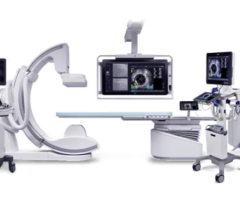November 12, 2009 – Catheter-directed therapy or catheter-directed thrombolysis to dissolve dangerous blood clots in the lungs saves lives and should be considered a first-line treatment option for massive pulmonary embolism, according to researchers in the November Journal of Vascular and Interventional Radiology.
"Modern catheter-directed therapy for acute pulmonary embolism saves lives, and we need to raise awareness about its safety and effectiveness not only among the general public but also within the medical community. It's a matter of life and death," said William Kuo, M.D., an interventional radiologist who is assistant professor and fellowship director of vascular and interventional radiology in the department of radiology at Stanford University Medical Center in Stanford, Calif. "In our study, we conclude that modern catheter-directed therapy is a relatively safe and effective treatment for acute massive pulmonary embolism and should be considered as a first-line treatment option."
Pulmonary embolism occurs when one or more arteries in the lungs become blocked from blood clots that break free and travel there. These clots most often begin as deep vein thrombosis (DVT) or blood clots within the deep leg veins. About 600,000 cases of acute pulmonary embolism are diagnosed each year in the United States, and an estimated 300,000 patients die. “If initiated early, minimally invasive catheter-directed therapy could save many of those lives," said Dr. Kuo, lead author of the study, "Catheter-directed Therapy for the Treatment of Massive Pulmonary Embolism: Systematic Review and Meta-analysis of Modern Techniques."
During the treatment, specially designed catheters deliver a clot-busting medicine directly into the clot. The catheters may also be used to mechanically break up clots and suction them away. This treatment offers less pain and less recovery time than traditional open surgery, Dr. Kuo said.
Stanford University researchers conducted a meta-analysis of the treatment on 594 patients in 18 countries who were treated between 1990 and 2008. The treatment was lifesaving in 86.5 percent of the cases studied and had only a 2.4 percent chance of major complications. Researchers found that not only was the treatment effective, but it also appeared much safer than the historical complication rates reported from injecting high-dose clot-busting medicine systemically or directly into the bloodstream where the drug can circulate throughout the body and cause major bleeding in up to 20 percent of patients.
Dr. Kuo began this study three years ago after he was asked to assist with a 62-year-old woman who had collapsed at home and was rushed to the emergency room with massive blood clots in her lungs. The patient had been given a large-dose intravenous infusion of clot-busing medicine, but that had failed.
While Kuo was initially consulted to place a special filter to prevent more clots from traveling from the legs to the lungs, he knew it would do little to save her. "I could see that she was quickly dying and there was no time to waste. I remember telling the staff, 'We can do more than just insert a filter. We can go after these clots using specially designed catheters,'" said Kuo. After obtaining consent from the family, Kuo made a tiny incision into the patient's neck and inserted a catheter into the vein. He used fluoroscopy to guide the catheter, navigating through the heart and finally reaching the blood clots within the lungs. He injected a clot-busting drug directly into the clots and then used the catheter to mechanically break up the clots before suctioning them out. "The results were immediate, and the treatment saved her life," said Dr. Kuo. "That experience inspired me to initiate further studies and to raise awareness of this emerging life-saving procedure.”
According to Kuo, the study addressed the use of catheter-directed therapy for treating the most severe or life-threatening form of pulmonary embolism, a "massive" pulmonary embolism. Additional studies are needed to see if the treatment should be initiated in those patients with less severe "sub-massive" pulmonary embolism, he added. To answer these questions and to analyze further treatment outcomes, Kuo's team is initiating the multicenter PERFECT (Pulmonary Embolism Response to Fragmentation, Embolectomy and Catheter Thrombolysis) registry. In the meantime, the Stanford researchers advocate the use of catheter-directed therapy for massive pulmonary embolism "as both an early and alternative treatment option at centers with the appropriate expertise," said Kuo.
For more information: www.SIRweb.org


 December 20, 2023
December 20, 2023 








